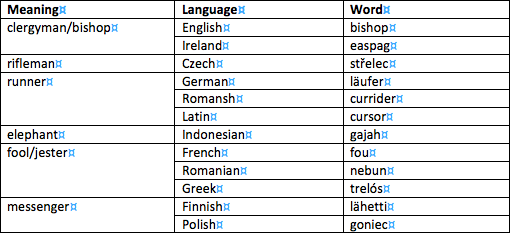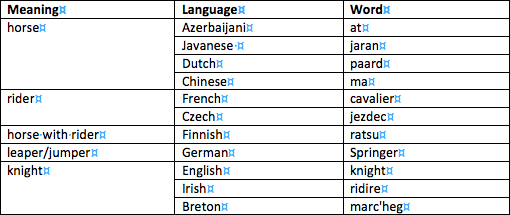Netflix miniseries The Queen’s Gambit illustrated the international culture of chess. As it turns out, the game’s spread around the globe is a story of translation. In this brisk and brainy rundown, Editor-at-Large Allison Braden tackles its evolution through time and space, setting up a board in which pawns can be farmers, bishops can be fools, and queens can be counselors.
In December of last year, Netflix miniseries The Queen’s Gambit smashed viewership records for a limited-run series on the site. In the show’s first month of streaming, over 62 million people around the world tuned in to the story of a young woman who overcomes several challenges in her quest to become a world chess champion in the 1960s. The series was based on Walter Tevis’s 1983 novel of the same name, and like readers before them, viewers rooted for plucky chess prodigy Beth Harmon. Her eventual triumph was, for many, a bright spot at the end of a long and difficult year.
You won’t become a grandmaster by watching the series. (In fact, one of the only aspects of the show that pro chess players took issue with was the speed of the games. In a concession to viewers, they were faster paced than matches at real tournaments.) But The Queen’s Gambit is a crash course in the culture of chess. It’s fiercely competitive, requires visual and strategic intelligence, and remains extremely male dominated (despite studies showing men aren’t inherently better at the game). Chess is also truly universal—and where there’s an international pastime, there are translators.
In the show, Harmon travels to Mexico, France, and the USSR. As her skill grows, her competitors increasingly hail from foreign countries, and as it becomes clear that the ultimate test of her ability will come in Moscow, she begins to study Russian. In the heady final scenes, commentators relay her moves in a variety of languages for listeners around the world. After The Queen’s Gambit was released, interest in chess boomed. One of the most popular ways to play is online. Chess.com boasts users from dozens of countries, and they can all play one other. Like many sports, chess transcends language; in a way, it is its own language. Players worldwide understand the pieces: the king’s hesitance, the queen’s might. The bishop, which can only move diagonally, speaks his own sideways tongue.
But our understanding of the pieces depends in part on what we call them—the king is not known as a king everywhere. Translators are well acquainted with the power resident in names and the way history is braided into language. The long history of chess reveals some interesting insights into how we talk about and understand this universal game. Here are a few:
- The origins of chess remain a controversial mystery, but historians have traced the game as far back as the sixth century CE. Several similar games preceded chess—some used dice, while others relied on a board with more than 100 squares—but the most likely immediate precursor was a game called chaturanga (“four arms,” a term you may know from yoga). The Sanskrit word refers to a military formation, which appeared in the Mahabharata, a major epic of ancient India. Chaturanga was a popular game in the seventh century and featured two characteristics that link it to all future versions of chess: the playing pieces had distinct abilities, and a single piece—the king in modern chess—held the key to victory.
- Chaturanga eventually evolved into a two-player game called shatranj, according to some historians, although the lineage between them remains murky. Like language itself, the game morphed as it spread across Asia, in the luggage of Silk Road traders and Buddhist pilgrims. Shatranj had arrived in China by 750 CE, and in the next few hundred years, it reached Korea and Japan. Chinese chess, which can be traced back to this era and is still played today, features a slightly different board and arrangement of pieces than “orthodox” chess. While chess unfolds on a board with eight files and eight ranks, Chinese chess has nine files, ten ranks, and a river between the fifth and sixth ranks. The river—and the implied notion of an “enemy camp”—underscores chess’s origins as a game of war.
- Chess soon stormed into Europe, on the heels of the Byzantine and Arabian empires. (A Baghdad historian and his pupil played the earliest recorded chess game. It turns up in a tenth-century manuscript.) Vikings, Slavs, and Muslims relayed the game to the far reaches of Europe. The word shatranj is believed to be a Persian innovation, a riff on the Sanskrit chaturanga, perhaps connected to the name of the critical piece: the shah (“king”). The Persians also introduced a few rules modern chess players will recognize: the practice of announcing “check” to warn the opponent of imminent danger to the king (and to keep the game from ending too early by accident), and the rule that the king may not move into or remain in check. Previously, the king could be captured, but these changes made that impossible. Checkmate—in which the king cannot move—became the only way to end a game.
- The Arabic term for checkmate was shāh māt (“the king is dead”), but according to the Chambers Dictionary of Etymology, the Arabs mixed up two similar Persian words: māta (“to die”) and mat (“to be astonished”). In the Persian language, an ancestor of Farsi, the game-ending phrase meant, essentially, “the king is stumped.” (You can hear echoes of shāh māt in the English word “checkmate,” a loanword from Old French.)
- After chess spent some time in Europe, North Africa, and western Asia, it did a U-turn and eventually journeyed back to its homeland during the Islamic conquest of India, bringing with it some of these innovations. The clues are in the language: in North India, the term māt can be traced back to Persian, and in Bengali, the word for “pawn,” borey, is linked to the Arabic word for the same piece, baidaq.
- In the fifteenth century, chess saw two more rule changes that helped it become the game we see in The Queen’s Gambit. The queen appears, for one. Before there was the all-powerful queen, who can move across the board more freely than any other piece, there was a hamstrung “counselor,” who could only move diagonally one square at a time. In chaturanga, there was also a piece that could only jump two squares diagonally, making it one of the weakest in the game. This piece, called the elephant, became the modern bishop, which has much more diagonal mobility.
- The first known written reference to the chess queen occurred in a Latin manuscript from 997 CE. In most European languages, the piece is feminine. The queen’s status as the most powerful piece on the board arose in an era when women were routinely subjugated, a contradiction that has provoked interest from scholars and lay players. Some have tied her power to the reign of Spain’s Isabella I, while others have connected the chess queen to the Virgin Mary. But not all languages refer to this piece as a woman: In some Asian and Eastern European languages, the piece’s name retains a reference to the counselor piece in shatranj, with meanings such as “vizier,” “minister,” or “adviser.” In Estonian, the queen is a flag or standard (lipp). (For translators, it’s interesting to muse on how the terms “queen” and “adviser” can alter perceptions of the game and its dynamics—and how this difference reflects translation into English from languages with grammatical gender.)
- The piece we know as the bishop was called pil (“elephant”) in Persian, which became fil in Arabic (the language didn’t have a P letter or sound) and took on the definite article al-. This construction, alfil or aufil, was adopted by several European countries—modern Spanish still uses alfil to refer to this piece. In France, aufil was replaced by fou (“jester” or “fool”) in the 1500s. That semantic shift is reflected in the Romanian and Greek words for the piece (nebun and trelós, respectively), which both mean “fool.” In Indonesia, the bishop is still referred to as an elephant (gajah). In Irish, he’s called an easpag (“bishop”), which comes from the same Latin word—episcopus—as the English “bishop.” Here are a few more words for the bishop from around the world:

- Thanks to the Moor invasion of the Iberian peninsula in 711 CE, Spain was among the first western European countries exposed to chess—a connection evident in Spanish. The Spanish word for the game, ajedrez, comes straight from shatranj.
- Chess pieces didn’t always have the relatively streamlined, portable design they have today. In the game’s earliest days, the pieces were likely simple, but they eventually evolved into intricate, ornate representations of animals or warriors. Because Islam prohibited these depictions, the pieces once again simplified and took on a more symbolic design—a factor that contributed to the game’s spread. Chess sets were more or less easy to make and transport. The focus became the intricacy of the game itself.
- The knight and pawn both point to the game’s martial origins—and both have consistent meanings in most languages. In Arabic, the pawn was called baidaq (“foot soldier”). “Pawn” is essentially a direct translation of this meaning, derived from the Latin pedon, which also refers to a foot soldier. The Spanish peon and French pion can likewise be traced back to pedis, the Latin term for “foot,” but take a slightly different meaning: “peasant.” The German Bauer has the same agricultural meaning, as do the Frisian boer and Ukrainian pishak, which both mean “farmer.” In Javanese, the pawn is known only as a “little person” (wong cilik).
- The knight piece originally represented the cavalry, a connection retained in most languages:

In the end, chess terminology tells a story of exploration and conquest, trade and turmoil. It’s a site of cross-cultural exchange and speaks to a universal history of war. Embedded in the sixty-four squares and thirty-two pieces of modern chess is a story of shared understanding and regional nuance. Chess, it turns out, is a story of translation.
Sources include Brittanica, Ari Luiro’s thorough chart and comparison of chess terms in various languages, Chess Maniac’s Etymology of Chess, the Online Etymology Dictionary, Grammarphobia’s etymology of “checkmate,” and Wikipedia entries on chess, the queen, and shatranj.
Image credit: Victor Vasarely
Allison Braden is a writer and Spanish translator. In addition to representing Argentina as an editor-at-large for Asymptote, she is a contributing editor to Charlotte Magazine and an editorial assistant for the academic journal Translation and Interpreting Studies. Her writing has appeared in Columbia Journalism Review, The Daily Beast, Asymptote, and Spanish and Portuguese Review, among others.
*****
Read more from the Asymptote blog:

